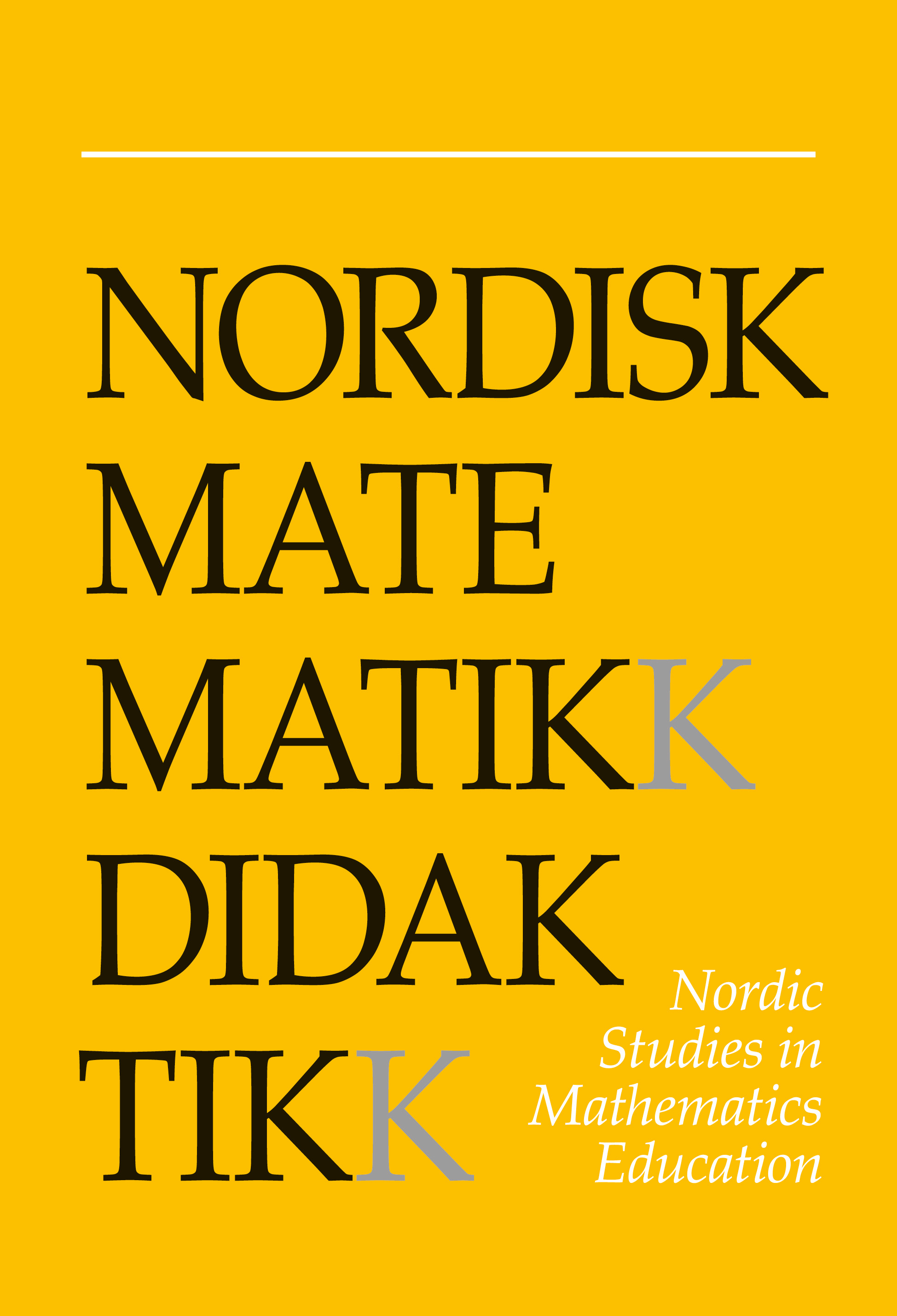Alternatives to standard algorithms – a study of three pupils during three and a half years
DOI:
https://doi.org/10.7146/nomad.v8i1.146703Abstract
In this article I will discuss a research project about the use of alternatives to the standard algorithms for the four arithmetic operations and especially the work of three girls who took part in the project. The girls were not taught any standard algorithms during their first five years at school. They were encouraged to use theirown written methods, including drawings, forall kindsof computations that theycouldnotdomentally. The three girls often worked together in a group. The girls were taught the standard algorithms during their sixth year at school.
The results I got were mainly that the girls could manage to find their own methods, often on their own but sometimes with the help of peers or teachers. I also found that the methods that they used, were mostly less effective than the standard algorithms, but that they were more like those used for effective mental arithmetic and computational estimation. The girls acquired good number sense and good ability in mental computation, and they preferred their own methods, even after they had been taught the standard algorithms.
References
Bauer, L. (1998). Schriftliches Rechnen nach Normalverfahren - wertloses Auslaufmodell oder überdauernde Relevanz? Journalfür Mathematik-Didaktik, 19(2/3), 179 - 200. https://doi.org/10.1007/BF03338867
Beishuizen, M., van Putten, C. M. & van Mulken, F. (1997). Mental Arithmetic and Strategy Use with Indirect Number Problems up to One Hundred. Learning and Instruction, 7(1), 87 - 106. https://doi.org/10.1016/S0959-4752(96)00012-6
Duffin, J. (1996). Calculators in the Classroom. Liverpool: Manutius Press.
Emanuelsson, G. & Emanuelsson, L. (1997). Taluppfattning i tidiga skolår. Nämnaren, 24 (2), 30-33.
Hedrén, R. (2000). Social konstruktivism i elementär aritmetik. Kan elever i år 2 - 5 göra skriftliga beräkningar utan de traditionella uppställningarna? Högskolan Dalarna: Kultur och lärande. Rapport 2000:1.
Kamii, C. (1985). Young Children Reinvent Arithmetic. Implications of Piaget's Theory. New York (USA): Teachers College Press.
Kamii, C. (1989). YoungChildren Continueto ReinventArithmetic. 2nd Grade. Implications of Piaget's Theory. New York (USA): Teachers College Press.
Kamii, C. (1994). YoungChildren Continueto ReinventArithmetic. 3rd Grade. Implications of Piaget's Theory. New York (USA): Teachers College Press.
Kamii, C; Lewis, B. A. & Livingston, S. J. (1993/94). Primary Arithmetic: Children Inventing Their Own Procedures. Arithmetic Teacher, 41(4), 200 - 203. https://doi.org/10.5951/AT.41.4.0200
Kilpatrick, J. (1988). Editorial. Journal for Research in Mathematics Education, 4(4), 274. https://doi.org/10.5951/jresematheduc.19.4.0274
Klein, A. S.; Beishuizen, M. & Treffers, A. (1998). The Empty Number Line in Dutch Second Grades: Realistic Versus Gradual Program Design. Journal for Research in Mathematics Education, 29(4), 443 - 464. https://doi.org/10.2307/749861
Murray, H., Olivier, A. & Human, P. (1994). Fifth Graders' Multi-Digit Multiplication and Division Strategies after Five Years' Problem-Centered Learning. In J. P. Ponte & J. F. Matos (Eds), Proceedings of the Eighteenth International Conference for the Psychology of Mathematics Education, 399 - 406. University of Lisbon.
Narode, R.; Board, J. & Davenport, L. (1993). Algorithms Supplant Understanding: Case Studies of Primary Students' Strategies for Double-Digit Addition and Subtraction. In J. R. Becker & B. J. Pence (Eds.), Proceedings of the Fifteenth Annual Meeting, North American Chapter of the International Group for the Psychology of Mathematics Education. Pacific Groves, CA (USA).
Plunkett, S. (1979). Decomposition and All that Rot. Mathematics in School, 8(2), 2 - 5.
Ralston, A. (1997). A Zero-Based Curriculum: What It Is and How It Might Be Used. In H. Neill, & A. Ralston, (Eds.), A Zero-Based Mathematics Curriculum. Proceedings of a Working Group at the Eighth International Congress on Mathematical Education, Seville, July 1997, 1 - 8. The University of Nottingham: The Shell Centre for Mathematical Education.
Reys, B. J. & Reys R. E. (1995). Perspektiv på number sense och taluppfattning. Nämnaren, 22(1), 28 - 33.
Reys, B. J.; Reys R. E. & Emanuelsson, G. (1995). Meningsfulla tal. Nämnaren, 24(4), 8-12.
Reys, B. J. et al (1995a). Vad är god taluppfattning? Nämnaren, 22(2), 23 - 25.
Reys, B. J. et al (1995b). Svenska elevers taluppfattning. Nämnaren, 22(3), 34 - 40.
Rockström, B. (1996). Matteboken. 4A och 4B. Stockholm: Bonnier Utbildning. Rockström, B. (1997). Matteboken. 5A och 5B. Stockholm: Bonnier Utbildning.
Shuard, H. et al (1991). Prime. Calculators, Children and Mathematics. London (UK): Simon & Schuster.
Vermeulen, N.; Olivier, A. & Human P. (1996). Students' Awareness of the Distributive Property. In L. Puig & A. Gutiérrez (Eds), Proceedings of the Twentieth International Conferencefor thePsychology ofMathematicsEducation,379-386. University of Valencia.
Downloads
Published
How to Cite
Issue
Section
License

This work is licensed under a Creative Commons Attribution-NonCommercial-ShareAlike 4.0 International License.



